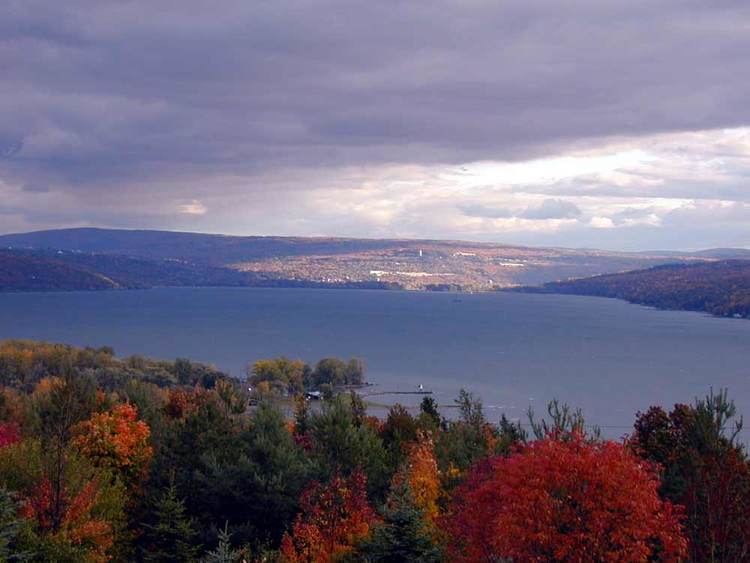Basin countries United States Area 172 km² Width 5.6 km | Lake type Ground moraine Catchment area 2,033 km (785 sq mi) Length 61 km Surface elevation 116 m | |
 | ||
Fish Atlantic salmon, Northern pike, Rainbow trout, Brown trout, Largemouth bass, Smallmouth bass, Lake trout, Yellow perch Similar Finger Lakes, Seneca Lake, Taughannock Falls State Park, Buttermilk Falls State Park, Robert H Treman State Park | ||
Cayuga Lake (/keɪˈjuːɡə/ or /kaɪˈjuːɡə/) is the longest of central New York's glacial Finger Lakes, and is the second largest in surface area (marginally smaller than Seneca Lake) and second largest in volume. It is just under 40 miles (64 km) long. Its average width is 1.7 miles (2.7 km), and it is 3.5 mi wide (5.6 km) at its widest point near Aurora. It is approximately 435 ft deep (133 m) at its deepest point.
Contents
- Map of Cayuga Lake New York USA
- LocationEdit
- Geographical characteristicsEdit
- Human impactEdit
- FolkloreEdit
- WineEdit
- References
Map of Cayuga Lake, New York, USA
LocationEdit
The city of Ithaca, site of Ithaca College and Cornell University, is located at the southern end of Cayuga Lake.
Villages and settlements along the east shore of Cayuga Lake include Myers, King Ferry, Aurora, Levanna, Union Springs, and Cayuga. Settlements along the west shore of the lake include Sheldrake, Poplar Beach, and Canoga.
The lake has one small island near Union Springs, Frontenac Island. It is one of only two islands in the Finger Lakes, the other being Squaw Island in Canandaigua Lake.
Geographical characteristicsEdit
Cayuga Lake is located at 42°41′00″N 76°41′46″W; 116.4 metres (382 ft) above sea level. Its depth, steep east and west sides with shallow north and south ends is typical of the Finger Lakes, as they were carved by glaciers during the last ice age.
The water level is regulated by the Mud Lock at the north end of the lake. It is connected to Lake Ontario by the Erie Canal and Seneca Lake by the Seneca River. The lake is drawn down as winter approaches, to minimize ice damage and to maximize its capacity to store heavy spring runoff.
The north end is dominated by shallow mudflats. An important stopover for migratory birds, the mudflats and marsh are the location of the Montezuma National Wildlife Refuge. The southern end is also shallow and often freezes during the winter.
Human impactEdit
The fish population is managed and substantial sport fishing is practiced, with anglers targeting smelt, lake trout and smallmouth bass.
Cayuga Lake is very popular among recreational boaters. The Allan H. Treman State Marine Park, a large state marina and boat launch, is located at the southern end of the lake in Ithaca. There are two yacht clubs on the western shore: Ithaca Yacht Club a few miles north of Ithaca, and Red Jacket Yacht Club just south of Canoga. There are several other marinas and boat launches scattered along the lake shore.
Cayuga Lake is the source of drinking water for several communities, including Lansing near the southern end of the lake along the east side, which draws water through the Bolton Point Municipal Water system. There are also several lake source cooling systems that are in operation on the lake, whereby cooler water is pumped from the depths of the lake, warmed, and circulated in a closed system back to the surface. One of these systems, which is operated by Cornell University and began operation in 2000, was controversial during the planning and building states for potential negative environmental impact. All the environmental impact reports and scientific studies have shown that the Cornell lake source cooling system has not yet had and will not likely have any measurably significant environmental impact. Furthermore, Cornell's system pumps significantly less warm water back into the lake than others further north which have been operating for decades, including the coal-fired power plant on the eastern shore.
The AES Cayuga electrical generating station operates in the Town of Lansing, on the east shore of Cayuga Lake. This coal-fired plant uses Cayuga Lake as a cooling source. In the late 1960s, citizens successfully opposed the construction of an 830-MW nuclear power plant on the shore of Cayuga Lake.
Rod Serling named his production company Cayuga Productions during the years of his TV series, The Twilight Zone. Serling and his family had a summer home at Cayuga Lake.
FolkloreEdit
The lake is the subject of local folklore. Cornell's alma mater makes reference to its position "Far Above Cayuga's Waters", while that of Ithaca College references "Cayuga's shore".
A tradition at Wells College in Aurora holds that if the lake completely freezes over, classes are canceled (though for only one day). According to Wells College records, this most recently happened in 1979 and 2015. However, other sources suggest that the only time the entire lake froze over solid end to end in the 20th century was in 1912.
Cayuga Lake, like nearby Seneca Lake, is also the site of a phenomenon known as the Guns of the Seneca, mysterious cannon-like booms heard in the surrounding area. Many of these booms may be attributable to bird-scarers, automated cannon-like devices used by farmers to scare birds away from the many vineyards, orchards and crops. There is however no proof of this.
WineEdit
Cayuga Lake is included in the American Viticultural Area with which it shares its name. Established in 1988, the AVA now boasts over a dozen wineries, four distilleries, a cidery, and a meadery.
